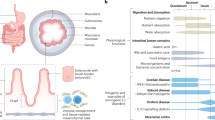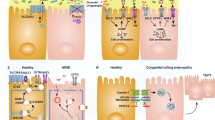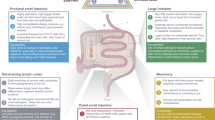Abstract
The primary functions of the gastrointestinal tract have traditionally been perceived to be limited to the digestion and absorption of nutrients and electrolytes, and to water homeostasis. A more attentive analysis of the anatomic and functional arrangement of the gastrointestinal tract, however, suggests that another extremely important function of this organ is its ability to regulate the trafficking of macromolecules between the environment and the host through a barrier mechanism. Together with the gut-associated lymphoid tissue and the neuroendocrine network, the intestinal epithelial barrier, with its intercellular tight junctions, controls the equilibrium between tolerance and immunity to nonself-antigens. When the finely tuned trafficking of macromolecules is dysregulated in genetically susceptible individuals, both intestinal and extraintestinal autoimmune disorders can occur. This new paradigm subverts traditional theories underlying the development of autoimmunity, which are based on molecular mimicry and/or the bystander effect, and suggests that the autoimmune process can be arrested if the interplay between genes and environmental triggers is prevented by re-establishing intestinal barrier function. Understanding the role of the intestinal barrier in the pathogenesis of gastrointestinal disease is an area of translational research that encompasses many fields and is currently receiving a great deal of attention. This review is timely given the increased interest in the role of a 'leaky gut' in the pathogenesis of gastrointestinal diseases and the advent of novel treatment strategies, such as the use of probiotics.
This is a preview of subscription content, access via your institution
Access options
Subscribe to this journal
Receive 12 print issues and online access
$209.00 per year
only $17.42 per issue
Buy this article
- Purchase on SpringerLink
- Instant access to full article PDF
Prices may be subject to local taxes which are calculated during checkout

Similar content being viewed by others
References
Cooper GS and Stroehla BC (2003) The epidemiology of autoimmune diseases. Autoimmun Rev 2: 119–125
Perl A (2004) Pathogenesis and spectrum of autoimmunity. Methods Mol Med 102: 1–8
Christen U and von Herrath MG (2004) Induction, acceleration or prevention of autoimmunity by molecular mimicry. Mol Immunol 40: 1113–1120
Miller A et al. (1991) Antigen-driven bystander suppression after oral administration of antigens. J Exp Med 174: 791–798
Rook GA and Brunet LR (2005) Microbes, immunoregulation, and the gut. Gut 54: 317–320
Sudo N et al. (2002) An oral introduction of intestinal bacteria prevents the development of a long-term TH2-skewed immunological memory induced by neonatal antibiotic treatment in mice. Clin Exp Allergy 32: 1112–1116
Weinstock JV et al. (2002) The possible link between de-worming and the emergence of immunological disease. J Lab Clin Med 139: 334–338
Dunne DW and Cooke A (2005) A worm's eye view of the immune system: consequences for evolution of human autoimmune disease. Nat Rev Immunol 5: 420–426
Shi H and Walker W (2002) T helper cell subclasses and clinical disease states. Curr Opin Gast 18: 711–716
Furuse M et al. (1993) Occludin: a novel integral membrane protein localizing at tight junctions. J Cell Biol 123: 1777–1788
Furuse M et al. (1998) Claudin-1 and -2: Novel Integral Membrane Proteins Localizing at Tight Junctions with No Sequence Similarity to Occludin. J Cell Biol 141: 1539–1550
Martin-Padura I et al. (1998) Junctional Adhesion Molecule, a Novel Member of the Immunoglobulin Superfamily That Distributes at Intercellular Junctions and Modulates Monocyte Transmigration. J Cell Biol 142: 117–127
Mitic LL et al. (2000) Molecular Physiology and Pathophysiology of Tight Junctions I. Tight junction structure and function: lessons from mutant animals and proteins. Am J Physiol Gastrointest Liver Physiol 279: G250–G254
Furuse M et al. (1999) Manner of Interaction of Heterogeneous Claudin Species Within and Between Tight Junction Strands. J Cell Biol 147: 891–903
Clayburgh DR et al. (2004) A porous defense: the leaky epithelial barrier in intestinal disease. Lab Invest 84: 282–291
Wang W et al. (2000) Human zonulin, a potential modulator of intestinal tight junctions. J Cell Sci 113: 4435–4440
El Asmar R et al. (2002) Host-dependent zonulin secretion causes the impairment of the small intestine barrier function after bacterial exposure. Gastroenterology 123: 1607–1615
Lorenz RG and Newberry RD (2004) Isolated Lymphoid Follicles Can Function as Sites for Induction of Mucosal Immune Responses. Ann NY Acad Sci 1029: 44–57
Lorenz RG et al. (2003) Isolated Lymphoid Follicle Formation Is Inducible and Dependent Upon Lymphotoxin-Sufficient B Lymphocytes, Lymphotoxin β Receptor, and TNF Receptor I Function. J Immunol 170: 5475–5482
Bjorkman PJ et al. (1987) The Foreign Antigen-Binding Site and T-Cell Recognition Regions of Class-I Histocompatibility Antigens. Nature 329: 512–518
Cuvelier C et al. (1987) Histopathology of Intestinal Inflammation Related to Reactive Arthritis. Gut 28: 394–401
Jang MH et al. (2004) Intestinal villous M cells: An antigen entry site in the mucosal epithelium. PNAS 101: 6110–6115
Hayday A and Viney JL (2000) The ins and outs of body surface immunology. Science 290: 97–100
Bilsborough J and Viney JL (2004) Gastrointestinal dendritic cells play a role in immunity, tolerance, and disease. Gastroenterology 127: 300–309
Rescigno M et al. (2001) Dendritic cells express tight junction proteins and penetrate gut epithelial monolayers to sample bacteria. Nat Immunol 2: 361–367
Mellman I and Steinman RM (2001) Dendritic Cells: Specialized and Regulated Antigen Processing Machines. Cell 106: 255–258
Alpan O et al. (2004) 'Educated' dendritic cells act as messengers from memory to naive T helper cells. Nat Immunol 5: 615–622
Rakoff-Nahoum S et al. (2004) Recognition of Commensal Microflora by Toll-Like Receptors Is Required for Intestinal Homeostasis. Cell 118: 229–241
Cario E et al. (2004) Toll-like receptor 2 enhances ZO-1-associated intestinal epithelial barrier integrity via protein kinase C. Gastroenterology 127: 224–238
Rumio C et al. (2004) Degranulation of Paneth Cells via Toll-Like Receptor 9. Am J Pathol 165: 373–381
Otte JM et al. (2004) Mechanisms of cross hyporesponsiveness to toll-like receptor bacterial ligands in intestinal epithelial cells. Gastroenterology 126: 1054–1070
Pasare C and Medzhitov R (2004) Toll-Dependent Control Mechanisms of CD4 T Cell Activation. Immunity 21: 733–741
Bashir ME et al. (2004) Toll-Like Receptor 4 Signaling by Intestinal Microbes Influences Susceptibility to Food Allergy. J Immunol 172: 6978–6987
Montalto M et al. (2004) Lactobacillus acidophilus protects tight junctions from aspirin damage in HT-29 cells. Digestion 69: 225–228
Rosenfeldt V et al. (2004) Effect of probiotics on gastrointestinal symptoms and small intestinal permeability in children with atopic dermatitis. J Pediatr 145: 612–616
Seehofer D et al. (2004) Probiotics partly reverse increased bacterial translocation after simultaneous liver resection and colonic anastomosis in rats. J Surg Res 117: 262–271
Madden KB et al. (2004) Enteric Nematodes Induce Stereotypic STAT6-Dependent Alterations in Intestinal Epithelial Cell Function. J Immunol 172: 5616–5621
Madden KB et al. (2002) Role of STAT6 and Mast Cells in IL-4- and IL-13-Induced Alterations in Murine Intestinal Epithelial Cell Function. J Immunol 169: 4417–4422
Shea-Donohue T et al. (2001) The Role of IL-4 in Heligmosomoides polygyrus-Induced Alterations in Murine Intestinal Epithelial Cell Function. J Immunol 167: 2234–2239
Ma TY et al. (2005) Mechanism of TNF-α modulation of Caco-2 intestinal epithelial tight junction barrier: role of myosin light-chain kinase protein expression. Am J Physiol Gastrointest Liver Physiol 288: G422–G430
Wang F et al. (2005) Interferon-γ and Tumor Necrosis Factor-α Synergize to Induce Intestinal Epithelial Barrier Dysfunction by Up-Regulating Myosin Light Chain Kinase Expression. Am J Pathol 166: 409–419
Bjarnason I et al. (2004) The G.U.T. of gut. Scand J Gastroenterol 39: 807–815
Wendling D (1992) Role of the intestine in the physiopathology of inflammatory rheumatism. Rev Rhum Mal Osteoartic 59: 389–392
Watts T et al. (2005) Role of the intestinal tight junction modulator zonulin in the pathogenesis of type I diabetes in BB diabetic-prone rats. PNAS 102: 2916–2921
Madara JL and Trier JS (1980) Structural abnormalities of jejunal epithelial cell membranes in celiac sprue. Lab Invest 43: 254–261
Schulzke JD et al. (1998) Epithelial tight junction structure in the jejunum of children with acute and treated celiac sprue. Pediatric Research 43: 435–441
Fasano A et al. (2000) Zonulin, a newly discovered modulator of intestinal permeability, and its expression in coeliac disease. Lancet 355: 1518–1519
Clemente MG et al. (2003) Early effects of gliadin on enterocyte intracellular signalling involved in intestinal barrier function. Gut 52: 218–223
Nikulina M et al. (2004) Wheat gluten causes dendritic cell maturation and chemokine secretion. J Immunol 173: 1925–1933
Thomas KE et al.: Gliadin Stimulation of Murine Macrophage Inflammatory Gene Expression and Intestinal Permeability are Myd88-Dependent. J Immunol, in revision
Danese S et al. (2004) Inflammatory bowel disease: the role of environmental factors. Autoimmun Rev 3: 394–400
D'Inca R et al. (1999) Intestinal permeability test as a predictor of clinical course in Crohn's disease. Am J Gastroenterol 94: 2956–2960
Wyatt J et al. (1993) Intestinal permeability and the prediction of relapse in Crohn's disease. Lancet 341: 1437–1439
Barmeyer C et al. (2004) Mechanisms of diarrhea in the interleukin-2-deficient mouse model of colonic inflammation. Am J Physiol Gastrointest Liver Physiol 286: G244–G252
Ivanov AI et al. (2004) Endocytosis of Epithelial Apical Junctional Proteins by a Clathrin-mediated Pathway into a Unique Storage Compartment. Mol Biol Cell 15: 176–188
Carratu R et al. (1999) Altered intestinal permeability to mannitol in diabetes mellitus type I. J Pediatr Gastroenterol Nutr 28: 264–269
Cooper BT et al. (1987) Intestinal permeability in diabetic diarrhoea. Diabet Med 4: 49–52
Mooradian AD et al. (1986) Abnormal intestinal permeability to sugars in diabetes mellitus. Diabetologia 29: 221–224
Davin JC et al. (1988) Increased intestinal permeability to (51 Cr) EDTA is correlated with IgA immune complex-plasma levels in children with IgA-associated nephropathies. Acta Paediatr Scand 77: 118–124
Rostoker G et al. (1993) Mucosal immunity in primary glomerulonephritis. III. Study of intestinal permeability. Nephron 63: 286–290
Wigg AJ et al. (2001) The role of small intestinal bacterial overgrowth, intestinal permeability, endotoxaemia, and tumour necrosis factor α in the pathogenesis of non-alcoholic steatohepatitis. Gut 48: 206–211
Yacyshyn B et al. (1996) Multiple sclerosis patients have peripheral blood CD45RO+ B cells and increased intestinal permeability. Dig Dis Sci 41: 2493–2498
Acknowledgements
Work by the authors was supported in parts by grants from the National Institutes of Health: DK-48373 and DK-66630 (AF) and AI/DK49316 (TSD).
Author information
Authors and Affiliations
Corresponding author
Ethics declarations
Competing interests
AF has economic interests in Alba Therapeutics, a company that works on the treatment of autoimmune diseases, including type 1 diabetes and celiac disease.
Rights and permissions
About this article
Cite this article
Fasano, A., Shea-Donohue, T. Mechanisms of Disease: the role of intestinal barrier function in the pathogenesis of gastrointestinal autoimmune diseases. Nat Rev Gastroenterol Hepatol 2, 416–422 (2005). https://doi.org/10.1038/ncpgasthep0259
Received:
Accepted:
Issue Date:
DOI: https://doi.org/10.1038/ncpgasthep0259
This article is cited by
-
Lactobacillus rhamnosus and Lactobacillus delbrueckii Ameliorate the Expression of miR-125a and miR-146a in Systemic Lupus Erythematosus Patients
Applied Biochemistry and Biotechnology (2024)
-
Increased Intestinal Permeability: An Avenue for the Development of Autoimmune Disease?
Exposure and Health (2024)
-
Gut permeability may be associated with periprosthetic joint infection after total hip and knee arthroplasty
Scientific Reports (2022)
-
Salinity significantly affects intestinal microbiota and gene expression in striped catfish juveniles
Applied Microbiology and Biotechnology (2022)
-
Review on pediatric coeliac disease from a clinical perspective
European Journal of Pediatrics (2022)



